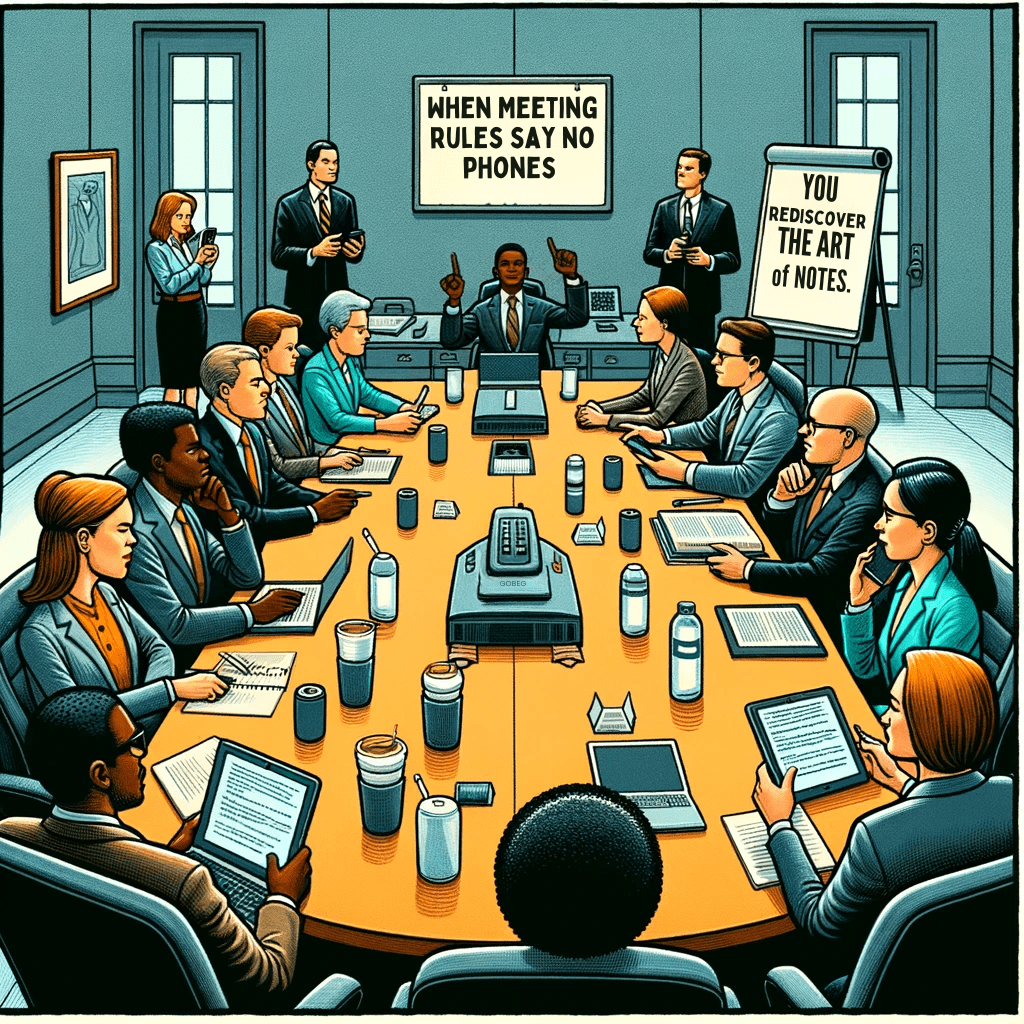
Imagine a meeting where every second counts, every opinion matters, and respect isn’t just a word, it’s the air we breathe. This isn’t a far-fetched fantasy, but a tangible, everyday reality we strive to create. In our universe, we don’t just meet; we converge with purpose, valuing each individual’s contribution as much as we value our collective time. It’s a world where open-mindedness and risk-taking aren’t just buzzwords but the very pillars that uphold our decision-making process. Here, every voice is heard, every perspective valued, turning our meetings into a melting pot of ideas and respect. We do this using meeting rules.
Meeting Rule: Unity
1. We start and end together. If someone is not in attendance, we don’t meet. If someone needs to leave early, we end the meeting when they leave.
2. We break together. If someone needs to make or take a call or use the restroom, we all break.
3. We don’t use cell phones or electronics, except for note-taking purposes. Multitasking serves no one. The crack-berry user distracts not only himself, but others trying to hold or gain his attention.
4. We treat everyone with an equal amount of respect, no matter their position, wealth, or power.
5. We share airtime. We don’t want to miss any valuable input, so we make sure everyone—including the most soft-spoken members–contribute.
6. We celebrate. Celebrating successes makes everyone feel supported and safe, which leads to more honesty and sharing, and a stronger sense of community.
7. We follow the rules. Everyone—not just the facilitator or leader—is responsible for making sure members don’t get out of line. If we see a foul, we call it.
Meeting Rule: Confidentiality
8. We maintain complete confidentiality unless or until a communication plan is developed. We may feel divided loyalties, but we don’t allow them to breach the trust of this group.
9. We respect privacy. When someone says they would not like to discuss the subject further, we allow them that courtesy.
10. We don’t tolerate negative sidebars during breaks or while meetings are in session. We share our concerns in the meeting with everyone present, not with just one or two members in the bathroom or in the hall.
Respect
11. We criticize ideas, not people. Members won’t feel like offering ideas or suggestions if they fear personal attack.
12. We’re engaged and active listeners. We stay with the conversation’s twists and turns, and ask questions to make sure we understand what we’ve heard.
13. We affirm others. We let them know that they’ve been heard.
14. We accept that others’ knowledge, pace of learning, and skills vary. We understand that the group is stronger for that diversity.
Meeting Rule: Participation
15. “No comment” does not count as participation. If someone hasn’t shared their opinion, we ask for it.
16. We don’t ramble. Some of us do our thinking out loud, which is fine in other settings, but not here. When we’re uncertain about what we want to say or what we’re trying to say, we pause to gather our thoughts (in our heads or on paper) and cede the floor to others.
17. Only one person talks at a time. If it’s worth saying, it’s worth waiting until everyone can give their full attention.
18. It’s okay to pass. If someone is really uncomfortable speaking on a subject or truly has nothing to add, they may say so. We allow others this courtesy, too, and don’t judge them for it.
Meeting Rule: Open-mindedness
19. We offer our knowledge freely and fully. We don’t withhold important information.
20. We speak our truth, even if it means going against the tide. We’re not afraid to say, “No” or “Wait a second” or “What about…?” One lone voice, when it’s strong and clear, can turn the tide.
21. We balance advocacy with inquiry. Since our point of view is already known to us, we spend time reaching deeper into others’ perspectives. We ask open-ended questions (not leading questions) and seek a new understanding.
22. We’re prepared to learn from others and to alter our beliefs.
23. We aren’t afraid to discuss the “un-discussable.” We try to help the group break out of old paradigms, tackle thorny problems, and move toward new, innovative solutions.
24. We don’t run with the first idea without testing it fully and seeking other solutions. We allow time for questions and counterarguments to rise.
Meeting Rule: Clarity
25. We ask the “dumb” questions. We’re not afraid to reveal what we don’t know.
26. We differentiate fact from opinion. We ask, “Do you know or do you think?” and sort material into these two important categories.
27. We’re all biased by negative experiences, so we try not to let those exert too much influence on current decisions.
28. We look for dead ends. If we sense a discussion is heading toward one, we explain how and why, so we can spend our time on more fruitful pursuits.
29. We’re willing to take risks and make mistakes. We know these lead to opportunities and new learning.
30. We seek to clarify by providing concrete examples. We don’t hide behind oblique and abstract language.
So, why do meeting rules matter?
It’s simple: because at CO2 Coaching, we believe in the transformative power of meaningful, respectful conversations. Our approach isn’t just about improving meetings; it’s about fostering a culture of genuine connection and shared growth. Each principle we uphold, from unity to open-mindedness, isn’t just a guideline but a stepping stone towards creating a more empathetic, insightful world of work. By embracing these values, we’re not just enhancing our discussions; we’re nurturing a community where every member flourishes.
In the end, it’s about more than just meetings. It’s about how we, at CO2 Coaching, help leaders and teams find their voice, connect their thoughts, and contribute to a collective wisdom that’s greater than the sum of its parts. Ready to elevate your meetings, and in turn, your leadership? Reach out to CO2 Coaching. Let’s turn every conversation into an opportunity for growth and every meeting into a wellspring of ideas.
Related Posts:
7 Reasons NOT to Have a Meeting
What’s the Write Way to approach meetings?
Do You Give Adequate Time to the Important Things?
Time is Money – with awesome time management tool



